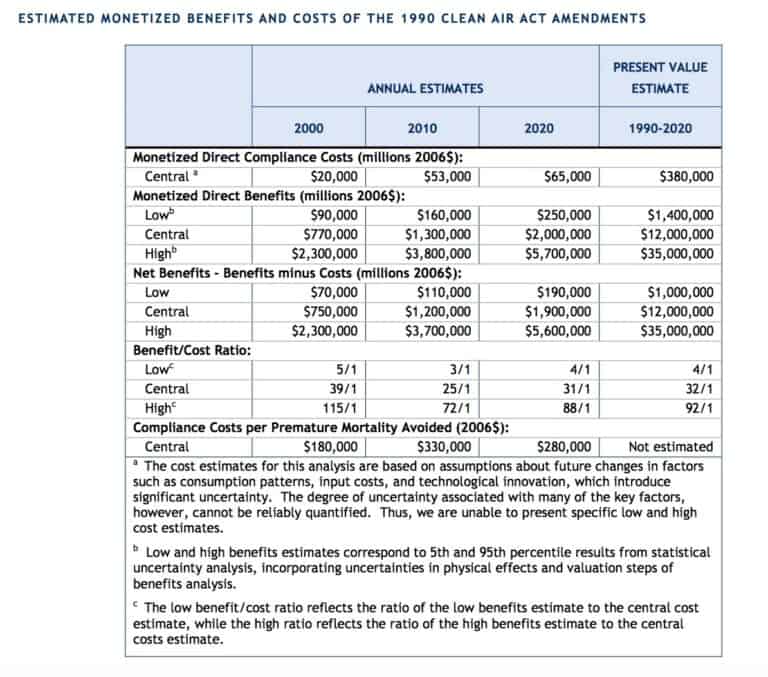EPA Administrator Scott Pruitt appeared on ABC’s This Week with George Stephanopoulos yesterday to discuss Trump administration efforts to roll back President Obama’s environmental initiatives, including fuel efficiency standards for vehicles, safeguards under the Clean Water Act, and an executive order undoing the Clean Power Plan which he said would be unveiled this week.
During the interview, Stephanopoulos correctly pointed out that if Trump kills these rules, the United States’ commitment to reduce greenhouse gas emissions under the Paris Climate Agreement becomes a “dead letter.”
Pruitt responded, “Look, since 1980, we’ve seen a 65 percent reduction in those pollutants that we regulate under the ambient air quality standards. We have done great work as a country striking the balance between jobs and our environment. This past administration, I think, took steps that were anti-jobs and anti-growth. And the Paris accord, I think, represents that.”
Pruitt appeared to be citing EPA Air Pollutant Emissions Trends Data that show from 1980 through 2015 total emissions of the six principal air pollutants dropped by 65 percent. The six pollutants often referred to as “criteria pollutants,” are carbon monoxide, lead, ground-level ozone, particulate matter, nitrogen dioxide, and sulfur dioxide. (Pruitt could have also picked-up the line from his friends either in the electric utility or oil and gas industry since leaders from both of those areas like to remind the public of what “they” have accomplished with regards to emissions reduction.)

Source: EPA
Nevertheless, it’s a bitter irony that Pruitt cites the Clean Air Act success story to justify the Trump administration’s attacks on clean air and water safeguards. The pollution reductions Pruitt cited were a direct result of the Clean Air Act and actions taken by the EPA. Yet Pruitt and his fossil fuel industry allies have criticized and joined forces to sue EPA to prevent Clean Air Act rules from becoming law.
As attorney general of Oklahoma, Pruitt filed or joined 14 lawsuits against the EPA, some specific to emissions including criteria pollutants, according to the Center for Media and Democracy:
- Regional Haze Rule (2011)
- Cross-State Air Pollution Rule (CSAPR) (2011)
- Mercury and Air Toxics Standards for Power Plants (MATS) (2012)
- Regulation of greenhouse gases under the Clean Air Act (2014)
- Draft rule of the Clean Power Plan (2014)
- Clean Power Plan (July 2015)
- Clean Power Plan (August 2015)
- Clean Power Plan (June 2016)
- Mercury and Air Toxics Standards for Power Plants (MATS) (2015)
- Waters of the United States (WOTUS) (2015)
- National Ambient Air Quality Standards (NAAQS) (2015)
- Methane Emissions (2016)
- Startup, Shutdown and Malfunction and Scheduled Maintenance (SSM & SM) State Implementation Plan (2016)
- Oil and Natural Gas Sector: Emission Standards for New, Reconstructed and Modified Sources (2016)
As EPA Administrator, Pruitt has said the EPA needs to be both “pro-jobs and pro-environment” – a talking point he used with Stephanopoulos.
However, Pruitt conveniently ignores his agency’s own peer-reviewed study from 2011 finding that clean air programs established by the 1990 Clean Air Act amendments may yield direct benefits to the American people that exceed compliance costs by more than 30-to-1, possibly by as much 90-to-1. Even the lowest benefits estimate exceeds costs by about 3-to-1.

Source: EPA
For decades, coal, oil, gas, and electric utility companies – and organizations they’ve funded – have demonized the EPA, as evidenced by these reports, quotes, and advertisements over the years:
- American Legislative Exchange Council’s report and model legislations: “EPA’s Regulatory Train Wreck”
- Americans for Prosperity’s rallies: “Stop The EPA Power Grab Rally”
- Heartland Institute’s Jay Lehr: The EPA is “fraudulent”
- National Black Chamber of Commerce’s Harry Alford: EPA regulations “a slap in the face to poor and minority families”
- Natural News’ Amy Goodrich: “EPA has pushed America into a ‘toxic legacy; with fraudulent science”
- Energy and Environment Legal Institute’s Steve Milloy: “These people [EPA scientists] validate and rubber-stamp the EPA’s conclusion that air pollution kills people.”
- Berman & Company’s EPA Facts advertisements: “The Environmental Protection Agency Is A Joke”
In addition to attacking the EPA and its scientists, utilities and other industries have also made misleading claims about what will happen to electricity rates when pollution rules are finalized. A 2014 report from the Center for American Progress highlighted examples of utilities that opposed the Clean Air Acts of 1970 and 1977. In 1977, for example, “electric utilities and other industries complained that scrubbers [to cut air pollution] were unreliable and costly.” A 1981 National Commission on Air Quality determined that those predictions were wrong. Then in 1989, the Edison Electric Institute and the president and CEO of Southern Company forecasted that EPA’s acid-rain program would increase bills up to 13.1 percent – a forecast that was “flat-out wrong”, according to the CAP report. The same type of fear-mongering by the fossil fuel industry has also occurred regarding the Clean Power Plan.
While Pruitt and his friends in polluting industries attack the EPA and the Clean Air Act and pretend no more work needs to be done under this highly successful law, it is important to note that 166 million people, more than half of all Americans, still live in counties where they are exposed to unhealthful levels of ozone and particle pollution.
August 2017 Update: A new report from the EPA found that since Congress passed the Clean Air Act in 1970, the economy has more than tripled while at the same time, the levels of six key air pollutants (carbon monoxide, lead, nitrogen dioxide, ozone, particulate matter and sulfur dioxide) have declined dramatically.

